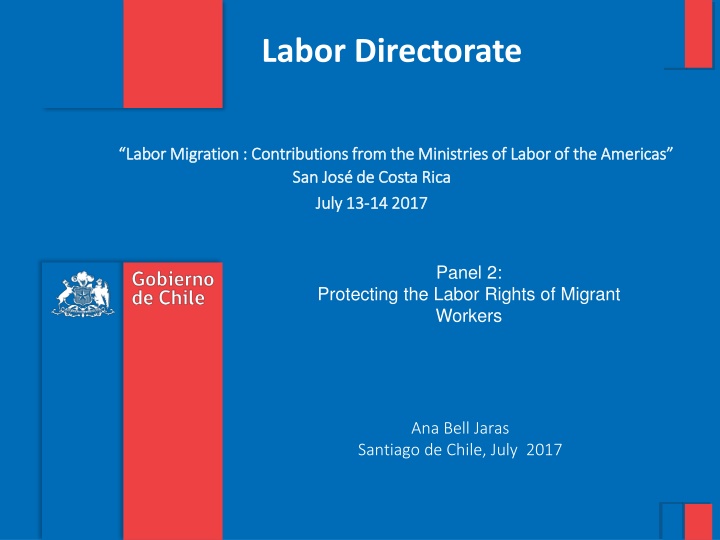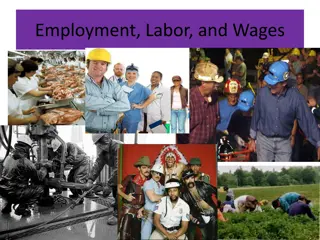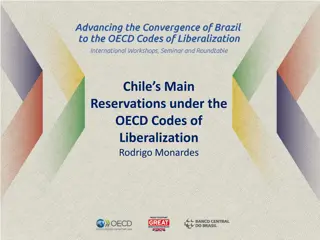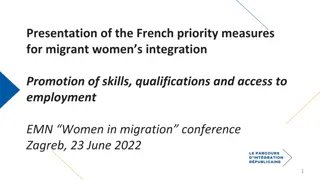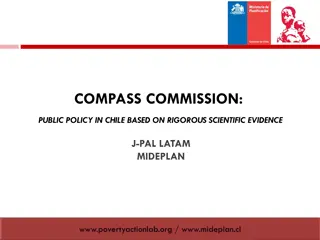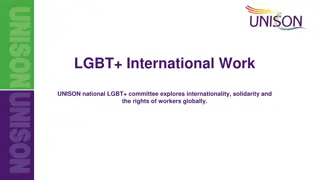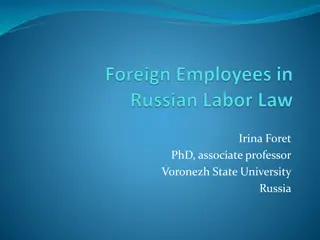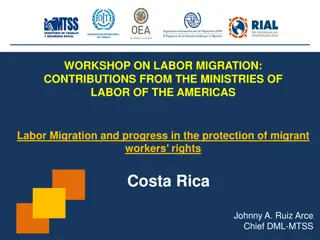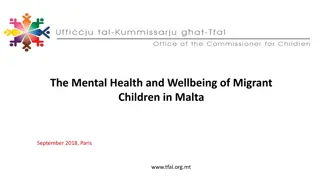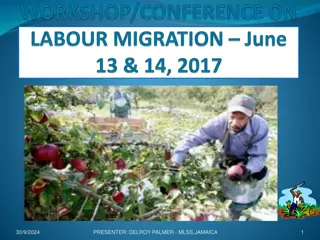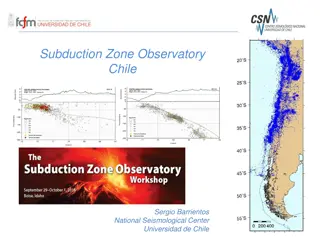Promoting Labor Rights of Migrant Workers in Chile
Chile has seen a significant influx of migrant workers in recent years, prompting the government to develop a comprehensive migration policy. The Ministry of Labor plays a key role in ensuring the protection and integration of migrant workers, emphasizing equal rights and opportunities for both migrants and Chilean workers. Initiatives include promoting regularization of migration, formalizing labor relations, and enhancing social protection. Intersectoral coordination and the creation of specialized roles within government services aim to facilitate the implementation of these efforts.
Download Presentation

Please find below an Image/Link to download the presentation.
The content on the website is provided AS IS for your information and personal use only. It may not be sold, licensed, or shared on other websites without obtaining consent from the author.If you encounter any issues during the download, it is possible that the publisher has removed the file from their server.
You are allowed to download the files provided on this website for personal or commercial use, subject to the condition that they are used lawfully. All files are the property of their respective owners.
The content on the website is provided AS IS for your information and personal use only. It may not be sold, licensed, or shared on other websites without obtaining consent from the author.
E N D
Presentation Transcript
Labor Directorate Labor Labor Migration Migration: : Contributions Contributionsfrom San Jos de Costa Rica San Jos de Costa Rica July July13 13- -14 2017 fromthe the Ministries Ministriesof Labor of of Labor of the theAmericas Americas 14 2017 Panel 2: Protecting the Labor Rights of Migrant Workers Ana Bell Jaras Santiago de Chile, July 2017
General Background Chile has become a new center of attraction for migrant workers in Latin America. In recent years, the foreign population living in the country doubled, from 154,643 foreigners in 2006 (1% of the total population) to 465,319 in 2015 (2.7% of the total population). (DEM) Migrations are part of the Government Program for the period 2014-2018. The program promotes the development of a migration policy and culture based on the promotion and application of the international instruments ratified by Chile on Human Rights and Migrants, with the State s active role in settlement actions, regular residence, protection of victims of trafficking and migrant development. In November 2015, the Migration Policy Council was constituted as a presidential advisory commission and the Technical Council for Migration Policy, with a double mandate: to revise the draft migration law prepared by the Ministry of Interior and Public Security and to prepare a Plan of Action on migration. In 2015 a Presidential Instruction was issued that states: "Employment as a Mechanism of Social Insertion." The Government should promote, on an equal basis with Chilean workers, the labor and social protection rights of migrant workers and their families, irrespective of their migratory status. Moreover, labor initiatives will aim to encourage regularization of Migration, the formalization of labor relations and co-responsibility between employers and employees. It reinforces the need for State services, especially those related to the Ministry of Labor and Social Welfare, "to generate goals and indicators that will make it possible to operate the axes and guidelines of the instructions with the ultimate purpose of making public state management in migratory matters As a consequence, the Ministerial Advisory Committee on Migrants and International Affairs was created by Decree of the Ministry of Labor and Social Welfare, in which all dependent institutions participate, with the objective of providing the technical inputs for the preparation of plans, programs and initiatives that The MINTRAB implement on this subject.
Ministry of Labor The Ministerial Advisory Committee on Migration and International Affairs is created by Decree MINTRAB It is chaired by the Minister of Labor and Social Welfare and its permanent members are the ten heads of service of this sector: 1. 2. 3. 4. 5. 6. 7. 8. 9. 10. Credit Management Pledge Undersecretary of Labor Undersecretary of Social Welfare Management of Work Superintendent of Social Security Superintendent of Pensions Institute of Social Welfare Institute of Occupational Safety National Training and Employment Service Chile Valora (Chile Values) The ministerial mandate instructs that each service dependent on MINTRAB incorporate goals on Labor Migration in its Collective Performance Agreements (2017) These goals have as a requirement two dimensions: Identification of the Migrant User and Tear Down Administrative Barriers. Two strategicpurposes: Improve intersectoral coordination for the achievement of common objectives. Have a Sector Migration Policy at the end of 2017. Each service has a "Technical Manager of Labor Migration" that can be consulted in matters of his or her competence
Management of Labor In the case of the Management of Labor, the collective goal was defined in the elaboration of a Plan of Action for 2017 in the field of migrant workers based on an institutional self-diagnosis. (2016). All this was built with the permanent Technical Assistance of the International Labor Office (ILO) for the Southern Cone . Both the self-diagnosis and the Action Plan were developed around the legal mandate and mission of the Institution: "Ensure compliance with labor legislation, social security and health and safety at work, promote the full exercise of freedom of association, promote social dialogue, strengthen systems for prevention and alternative solutions to conflicts, allowing fairer and more equitable relations between workers and employers, contributing to a democratic system of industrial relations. This mandate forms a very different Management of Labor in Chile compared to the majority of counterpart institutions in the Region since the goods and services it provides go far beyond the Single Audit or Inspection, which constitutes a strategic institution for the Labor relations and at the same time a complex organization of its management, functional as territorially based, and since it covers the whole country with more than 80 offices. Services provided: Audit. Systems of prevention and alternative solution of conflicts and social dialogue. Promotion of freedom of association and technical assistance. User Attention. Opinions. Therefore, the 2017-2018 Migrant Work Action Plan intervenes in all areas of the institution in a cross-cutting way to improve its management, information and training capacities to respond to the growing needs of migrant workers. With focused on: Inclusion - Non-discrimination The determining factor for the construction of the Plan was the participative self-diagnosis that not only addressed normative and management aspects but also cultural aspects and the willingness to change practices.
The Migrant User in the Management of Labor The migrant population in Chile by 2015: 465,319 - 51.9% Women 48.1% Men. 74.9% come from South America: Peru, Colombia, Argentina, Ecuador, Venezuela, Haiti Haiti: 2013 / 5,575 - 1015: 15, 705 (281%) new, cultural and idiomatic challenges. 72% Labor Reasons: Wage earners 81.5% / Own account: 14.8% (rate very similar to national) Employers: 3.6%: Immigrants with investment capacity, sectors with greater presence of migrant employers, the largest group is in commerce, restaurant and hotel industry and secondly, community, social and personal services Comparatively they have a higher average educational level at the national level, a working age ratio of H and M that allows a higher participation rate than the national level, a higher proportion of women, a lower rate of unemployment vs. a national level. Employment is mainly in the commerce sector, restaurants and hotels, domestic service (private households with domestic service), construction, real estate and services to companies. Increase in agriculture. According to administrative and statistical records related to complaints of violations of labor regulations to foreign workers: The number of complaints is increasing in the last 3 years. (2014 / 2,1% - 2015 / 2,6% - 2016 / 3,7) Disaggregated by sex the T. duplicate the denunciations of T. Of the set of 30 subjects most denounced by national T. and 30 foreign T. And the 5 most denounced in the two are countered, they coincide in 3 of them and if they widen 10 they coincide in 9. Between 2011 and 2014, there were 45,000 reports of labor informality, the highest number in 2 of the 3 sectors with the highest migrant presence, commerce, hotels, restaurants, and of course the national T. are the major denouncers, sectors where the largest extension Of the protective scope of the DT.
Self-diagnosis: Challenges to face with labor migration Self-diagnosis sheds light on a number of issues that DT should address in order to serve this group of workers who are most vulnerable, in terms of training, information, awareness and dissemination. Background Problem Areas: National Normative Framework discordant with the DT Mission Difficulties in identifying, characterizing and quantifying migrant workers. Procedimientos de trabajo para atender el trabajo migrante en la Instituci n desactualizados. Outdated working procedures to deal with migrant work in the Institution. Weaknesses in other dimmensions: Information Available at the Institution: Normative Knowledge; Migratory Management; National / international level statistics; Systematized records; Visibility of specific needs, visibility in analysis of working conditions Program Offer: Migrant workers; Organization of trade unions; Employers; Civil society organizations, citizenship Coordination with Public and Private Institutions; Institutional Culture: The communication culture of the DT does not include the specificity of migrant workers in its products (images, pamphlets, language, posters); In certain regions and units the migrant worker is perceived as a problem and they still operate conceptions, prejudices and negative views of the people consulted on these workers.
Migrant workers insufficiently Informed of their labor rights User with lower visibility of specific needs. Less effective response / strategic products for migrant work Increased attention times for migrant users Difficulties in the traceability of the requirement Migrant workers repeat their consultations in the offices Heterogeneityof responses Workoverload Personal time is used in the in the search of information to solve queries and / or requirements Poor inclusion of the image of migrant workers in the DT media Scarce planned monitoring activities, promotion of freedom of association and application of mechanisms of social dialogue. Dispersion of demands to other institutions that are involved Follow-up of the consultation or activity developed for migrant users in the internal system is insufficient and heterogeneous Organized response and type of special face-to- face or non-face-to-face assistance to migrant users reduced Responses to requests for general and specific information is insufficient PROBLEMS Units seek in other institutions the necessary information. Migrant labor with lack of equity mechanisms in products and services INSTITUTIONAL COMPETENCIES INSUFFICIENT TO RESPOND TO THE SPECIFICITIES OF MIGRANT WORK TREE OF Insufficient knowledge of the officials of the current national and international regulations on migrant labor. Poor characterization of users and foreign beneficiaries of DT in the registration and information systems. Lack of information on migrant labor for the planning of organized activities. The specificity of the migrant worker and his labor rights is scarcely expressed in the communicational culture Insufficient knowledge on geographical and sectorial concentration and on socio- cultural characteristics of the migrant population Low knowledge of the requirements and documents necessary for regularization. Deficits in registration and systematization of information on migrant workers Attended by the DT. Deficient knowledge of officials on social rights and benefits for migrant labor. Presence of prejudices on the part of some officials Low knowledge on socio-cultural characteristics of the migrant population Difficult communication with foreign non-Spanish speaking workers and employers. Little training requirements for dealing with migrant labor demands Shortageof institutional informationsourceson migrant labor Poor coordination with other public and private institutions that are involved .. 7
Greater effectiveness of response / strategic products towards migrant labor Migrant workers Informed of their labor rights Migrant workers seen as users with specific needs Less attention times for migrant users Migrant workers do not repeat their consultations in the offices Improve the traceability of the requirement Homogeneity of responses Standardized workload Increased programmed monitoring activities, promotion of freedom of association and application of mechanisms of social dialogue. Unification of the demand for information to other institutions involved Personal time is not used in the search of information to resolve queries and / or requirements DT's internal media include migrant work as a target audience. Organized response and type of special face-to-face or non- face-to-face assistance to migrant users increased Inclusion of the principle of equity in products and services towards migrant labor Relevant response to requirements for general and specific information. Information availableat the Institution On migrant labor. Internal system allows monitoring of the query or activity developed for migrant users INSTITUTIONAL COMPETENCES INCREASED TO RESPOND TO THE SPECIFICITIES OF MIGRANT WORK 8
What goods or services should the Action Plan produce to achieve the goal of increasing institutional competencies? 2 1 3 Migrant dimension incorporated into the ENCLA Information system systematized by other institutions on available migrant labor Coordination protocols with public and private institutions involved signed 5 4 Specialized training program by year to increase staff competencies. Migrant module in the implemented ETF competency training program. 6 7 Protocols of coordination with other public institutions involved in the regularization signed Specific training module on immigration regularization Implemented 8 9 10 System of registration and institutional information contains the foreign user. DT Equity Mechanisms for Embedded Migrant Work Legal information on available migrant labor. The 10 components were validated incorporating the modifications and contributions to the indicators and the activities and, they became the matrix of the Plan of Action of Migrant Work 2017-2018 9
OBJECTIVES OF THE 2017-2018 PLAN OF ACTION Strategic Objective To establish the bases for a public institutional, transverse and permanent policy of the Management of Labor. General Objective To increase the institutional competences that allow to respond to the particularities of the migrant work. Specific Objectives: Count on information on migrant labor produced by other institutions at the disposal of officials. Generate institutional information on migrant work within the framework of the mission of the Service. Increase the skills of officials to improve responses to migrant workers. Shed light in the institution on this new user and its peculiarities Generate collaborative work with other public and private institutions occupied by the migrant population, especially with regard to migrant work. 10
Operational Matrix of the Action Plan COMPONENTS RESPONSABLE FOR EXECUTION 1. System for gathering information systematized by other institutions on available migration Dept. Studies Management Cabinet 2. Coordination protocols with other public and private institutions involved and signed. Management Cabinet 3. Migrant dimension incorporated in the ENCLA. Dept. Studies 4. Migrant module in the implemented ETF competency training program. Human Resources Department Technical Training School 5. Training program specialized by year in order to increase competencies on migration issues. Management Cabinet Regional Directions 6. Specific training module on the implemented immigration regularization. Office of Communications Support Technical Training School 7. Protocols of coordination with public institutions involved in the regularization signed. Management Cabinet Dept. Inspection Regional Directions 8. System of registration and institutional information contain the foreign user Information technology; Dept. Attention Users; Dept. Inspection, Dept. Labor Relations, Dept. Legal, Dept. Studies; Dept. Management and Development, support Office of Management. 9. Embedded DT equity mechanisms for migrant work. Dept. Studies; Sub Direction; Dept. Communications; Dept. RRLL. 10. Available legal information on migrant labor. Dept. Inspection; Dept. Legal. 11
In Conclusion The dimensions that the Action Plan 2017-2018 address through its components commit practically all the units of the TD, and the Regional Directorates. The production of goods and services proposed in order to increase the competencies of the institution in relation to migrant labor, would allow: Use of information resources generated by other institutions; Generation of in-house information according to the mission of the service; Collaborative work with other institutions, contributing to a national policy on migration; Decrease of gaps in the competencies of officials on the issue; Some cultural changes in the organization to make visible the migrant worker as a user with specific needs and to diminish possible prejudices. Macro activities were raised because, in order to achieve the production of the components, more than one unit of the Service should converge, thus optimizing the aggregation of value. The scope of the implementation of this proposed Action Plan requires complex monitoring and evaluation, and a lot of political will for it, the Management Cabinet is responsible for the management of its execution and subsequent evaluation. Finally, the proposed Action Plan 2017- 2018 offers the installation of goods and services whose continuity will allow, in time, for it to be considered as bases for a permanent policy of the institution on labor migration, thus contributing to a national policy on this subject. Work Management Office July of 2017 12
